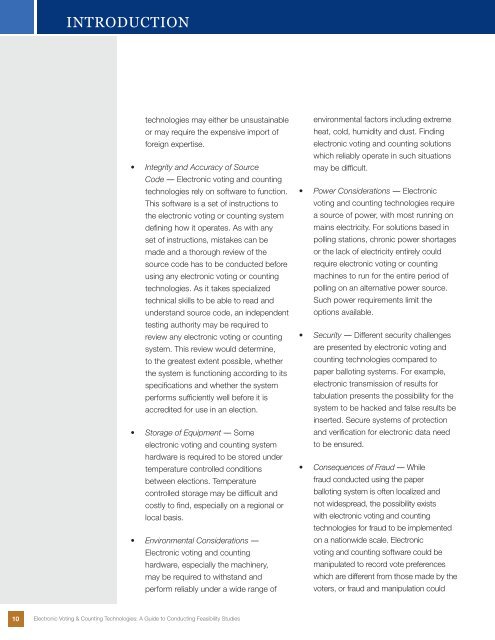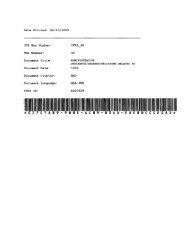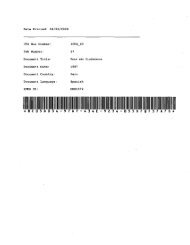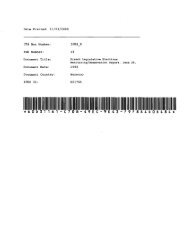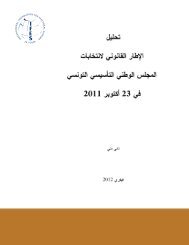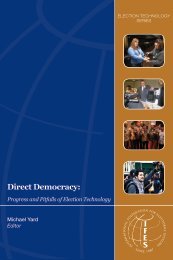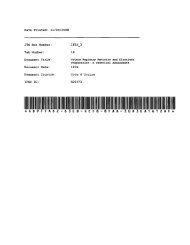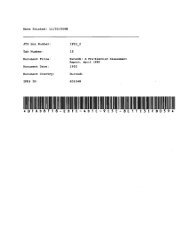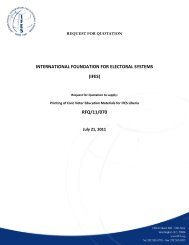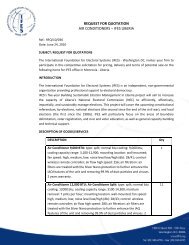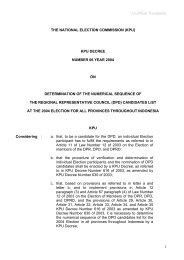Electronic Voting & Counting Technologies - IFES
Electronic Voting & Counting Technologies - IFES
Electronic Voting & Counting Technologies - IFES
- No tags were found...
You also want an ePaper? Increase the reach of your titles
YUMPU automatically turns print PDFs into web optimized ePapers that Google loves.
INTRODUCTIONINTERNATIONAL ELECTORAL STANDARDStechnologies may either be unsustainableor may require the expensive import offoreign expertise.• Integrity and Accuracy of SourceCode — <strong>Electronic</strong> voting and countingtechnologies rely on software to function.This software is a set of instructions tothe electronic voting or counting systemdefining how it operates. As with anyset of instructions, mistakes can bemade and a thorough review of thesource code has to be conducted beforeusing any electronic voting or countingtechnologies. As it takes specializedtechnical skills to be able to read andunderstand source code, an independenttesting authority may be required toreview any electronic voting or countingsystem. This review would determine,to the greatest extent possible, whetherthe system is functioning according to itsspecifications and whether the systemperforms sufficiently well before it isaccredited for use in an election.• Storage of Equipment — Someelectronic voting and counting systemhardware is required to be stored undertemperature controlled conditionsbetween elections. Temperaturecontrolled storage may be difficult andcostly to find, especially on a regional orlocal basis.• Environmental Considerations —<strong>Electronic</strong> voting and countinghardware, especially the machinery,may be required to withstand andperform reliably under a wide range ofenvironmental factors including extremeheat, cold, humidity and dust. Findingelectronic voting and counting solutionswhich reliably operate in such situationsmay be difficult.• Power Considerations — <strong>Electronic</strong>voting and counting technologies requirea source of power, with most running onmains electricity. For solutions based inpolling stations, chronic power shortagesor the lack of electricity entirely couldrequire electronic voting or countingmachines to run for the entire period ofpolling on an alternative power source.Such power requirements limit theoptions available.• Security — Different security challengesare presented by electronic voting andcounting technologies compared topaper balloting systems. For example,electronic transmission of results fortabulation presents the possibility for thesystem to be hacked and false results beinserted. Secure systems of protectionand verification for electronic data needto be ensured.• Consequences of Fraud — Whilefraud conducted using the paperballoting system is often localized andnot widespread, the possibility existswith electronic voting and countingtechnologies for fraud to be implementedon a nationwide scale. <strong>Electronic</strong>voting and counting software could bemanipulated to record vote preferenceswhich are different from those made by thevoters, or fraud and manipulation could10<strong>Electronic</strong> <strong>Voting</strong> & <strong>Counting</strong> <strong>Technologies</strong>: A Guide to Conducting Feasibility Studies


